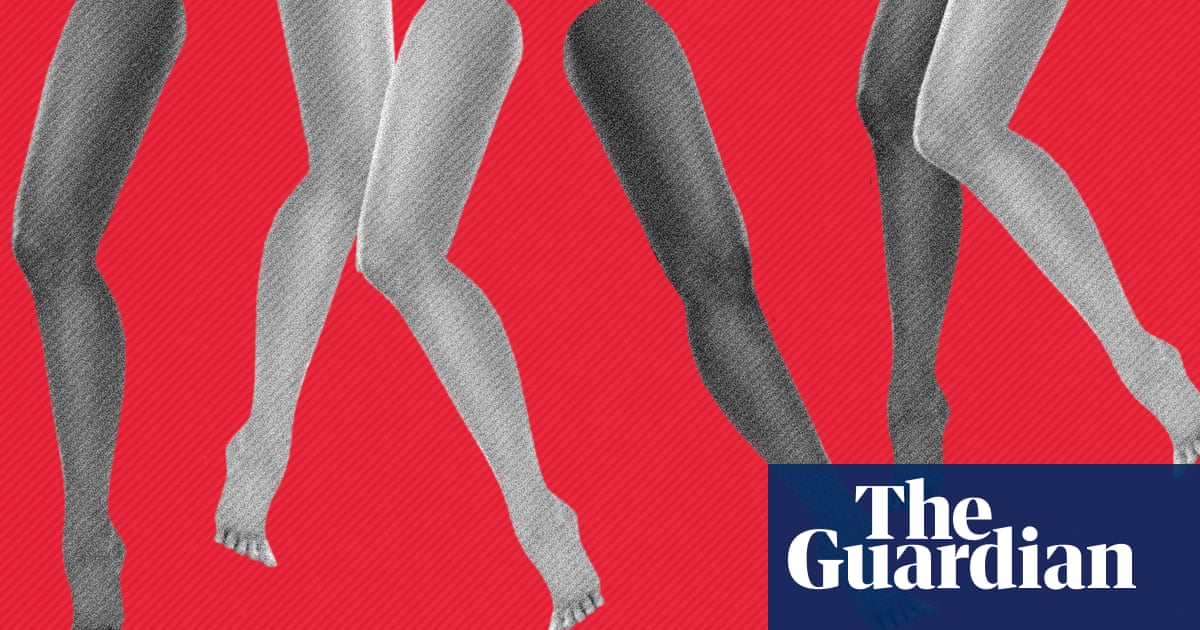I’d always known something was wrong with my legs. When I was a teenager, my best friend and I shared her full-sized bed – she would wake me up, giggling: “Lying next to you is like trying to sleep through an earthquake!” Now I’m 45, and my boyfriend says the same thing.
I have Restless Legs Syndrome (RLS), a condition that affects up to 14% of the global population, according to the Restless Legs Syndrome Foundation. Every night, I feel an uncontrollable urge to move my legs. I get up and walk – a trusty but temporary solution. It stops. I lie back down. It starts again. I try to ignore it, but I can’t. The movements persist in arrhythmic cycles for hours. By bedtime I’m exasperated, in tears. I just want to sleep.
Even though it’s a recognized neurological disorder known to impact quality of life, I’ve heard more excuses than solutions from my doctors. One told me it’s a mental health problem and that I should see a shrink. Another said there’s nothing I can do, then prescribed sleeping pills that carry known dependency issues.
My mom and grandma had the same issue. They called it “twitchy legs”, reporting that there’s nothing to be done about the misfortune. But these symptoms came six, if not seven, nights per week. Did I really just have to live with it?
In my mid-20s I went down an online spiral in chat forums with fellow sufferers. One said to put a bar of soap under the fitted sheet because magnesium, a common ingredient, can help alleviate leg cramps. Another swore the cure was lying with your legs straight up against a wall for 15 minutes before bed. My cousin bought a device that vibrates the legs, using it for 30 minutes at night. None of it worked for me.
Finally, exhausted from chronic lack of sleep and desperate for help, I went to a new primary care doctor. “What does it feel like?” she asked, writing notes as I cried, describing the nightly leg tremors that kept me from sleeping. I explained that the twitching often felt like bugs crawling – not on my skin, but beneath it – and the worst part was the powerlessness. I couldn’t make it stop, and I didn’t sleep well. The rest of my life felt dulled because of it.
She acknowledged it was likely RLS. But during that same appointment I also received the shocking and life-threatening diagnosis of type 1 Diabetes. At the age of 27, I was among a low percentage of adults whose symptoms didn’t activate until later in life. I began insulin therapy, and my doctor ignored the RLS.
I appreciated the need to prioritize care for a grave issue. Still, I felt hopeless, and the anxiety of diabetes management didn’t help me sleep more soundly.
Years passed, and my primary care doctor refused to address the RLS while I managed my diabetes. She glossed over my questions, saying medicine couldn’t help, so I should just focus on the diabetes.
I pleaded with my endocrinologist to offer advice. She suggested I give up caffeine. I ended my once-a-day coffee ritual immediately, and after four days of extreme headaches the RLS improved slightly in severity, but not in frequency. My legs continued to dance every single night.
In 2022, I saw an ad claiming RLS could be helped by intravenous laser ablation, whereby a laser fiber is inserted through a catheter to improve blood flow in the legs. I went through six months of treatments, visiting the clinic every three or four weeks for ultrasounds and painless procedures to reduce inflammation around the valves in my veins.
I thought I was cured. My legs felt lighter, looser somehow, unencumbered by the voracious twitching at night. But, within a year, my symptoms returned, persistent as ever.
Every night, I’d toss and turn in bed, eventually pacing the hallway outside my bedroom. My Apple watch tracked my activity: 5,000; 10,000; sometimes 20,000 steps. Then I would tuck myself back into bed, eyes welling from sheer frustration.
The movement never stopped, but my body would usually succumb to exhaustion and I’d eventually fall asleep hours after my planned bedtime. The severity of symptoms seemed to worsen as I aged.
During my divorce, I began taking Zoloft. Weeks in, my restlessness was worse than ever and I hadn’t slept in days. At an appointment with my psychiatrist, I pleaded my case and she researched any potential link. And there it was: Zoloft can increase serotonin levels and thereby exacerbate RLS. It took more than six months to responsibly wean off the medication.
Determined to find a cure, last year I started writing about RLS and spoke to experts in sleep medicine. Andrew R Spector, MD, associate professor of neurology at Duke University School of Medicine and author of the new book Navigating Life with Restless Legs Syndrome, told me that RLS is one of the most underappreciated conditions in neurology. The root cause of RLS is still unknown but experts theorize it could be genetic, related to iron deficiency or lifestyle choices such as drugs, alcohol, caffeine and lack of sleep. The RLS Foundation says that medications and dopamine levels may be a factor.
Spector explained that RLS is a clinical diagnosis, based entirely on reported symptoms rather than a test – decades of my testimony should have been enough. He shared typical treatment plans and my mouth hung agape. None of my doctors had ever gone over these with me.
after newsletter promotion
First, patients are told to eliminate substances like alcohol, nicotine and caffeine, which may exacerbate symptoms. Next is a check of blood iron levels, to assess whether an iron supplement is appropriate. Doctors may prescribe drugs for patients that are known to relax the muscles, including gabapentin and pregabalin.
But there was one treatment I was glad to have missed. Dr John Winkelman, MD, PhD, Massachusetts general hospital chief of sleep disorders clinical research program, told me that three drugs commonly prescribed for nearly two decades were, with long-term use, actually harming patients more than helping. These drugs, called dopamine agonists, caused RLS to spread to the arms, torso and other parts of the body. It was almost unfathomable to imagine the misery of broadening symptoms.
The American Academy of Sleep Medicine (AASM) released new guidelines late last year to exclude dopamine agonists from the RLS treatment protocol. The only noted exceptions are terminally ill patients who will not use the drugs long-term.
Dopamine agonists alleviate symptoms in the short term, but with long term use paradoxically cause problems, said Dr Andy Berkowski, MD, a board-certified sleep physician and founder of ReLACS Health sleep clinic. The drugs worsened the condition – a permanent effect that was only partially reversible. What’s worse, patients who took higher doses over time formed a chemical dependency and could not easily stop.
“No one has an easy time coming off these drugs,” said Spector. Withdrawal symptoms can include anxiety, depression, insomnia, exacerbation of RLS symptoms, and even suicidal thoughts. I wished I had found a doctor who believed me earlier in my life. But perhaps I had also avoided tremendous strain because I had never taken one of these drugs.
Opioids are the final treatment option, typically considered only if others prove ineffective. In 2017, Winkelman established a national RLS opioid registry with over 500 participants to track whether very low doses produced long-term relief. He reported that after six years, 20% of people were able to reduce their dosage, 30% stayed the same and 50% needed a slightly higher dose to experience relief.
Spector reported that he has not seen patients with RLS becoming dependent on low-dose opioids, and many doctors I spoke with were not concerned with the low level doses that provided effective relief for patients. Still, I decided against any treatment option that involved them.
What finally helped me was getting my iron levels checked by a sleep medicine specialist last year, a routine step overlooked when I first confirmed my diagnosis almost 20 years ago. He explained that RLS is actually not a condition of the legs – rather, it is related to brain iron levels.
My blood iron test results came back indicating iron supplements would be appropriate, which instantly induced both fury and relief. I started taking them, which has lessened the severity and frequency of symptoms by about half. After two decades without the proper care, a simple over-the-counter supplement made a significant difference.
Although my symptoms have improved, RLS is still a significant burden. I often wonder how much of my life I’ve lost to distraction. The hours I’ve spent trying not to think about my condition or spent feeling tired are impossible to measure.
All the movies I could have enjoyed, while I was instead pacing around the theater doorway. How much more refreshed I would have felt for a week of work in Sydney had I gotten a wink of quality sleep on the 20+ hour journey. So many times I would have loved to sit and read a book in the evening without diverting any attention to my legs.
I’ve spent precious hours feeling incredulous after strange looks or condescending comments from colleagues or acquaintances. “That’s not a real thing,” they say, or “Sounds like it’s all in your head” – followed by a nostril flare or eye roll. To some, the condition may always sound fake.
But when I meet a fellow sufferer, it’s a near instant bond. We quickly commiserate – “It’s not crazy to wish you could cut your legs off! ” – and share recommendations.
I’ve always lived my life restlessly: business travel, a new home every few years, a relentless pursuit for something more. Some have called it ambition; others say I’m driven. I just think I have a hard time sitting still – physically and mentally.
There’s undoubtedly a propulsive energy that keeps me going. Is my RLS the kinetic force? Perhaps it is. And maybe not.
Of course, I’ve suffered for decades. But I like the idea that my physical restlessness parallels how I navigate the rest of my life. Certainly, thinking about RLS as something more than twitchy legs is the only thing that partially calms my brain as I saunter into bed hoping, praying, that tonight I might finally lay still.










